Furutech FP-TCS31 power cable and FI-28/FI-38 connectors
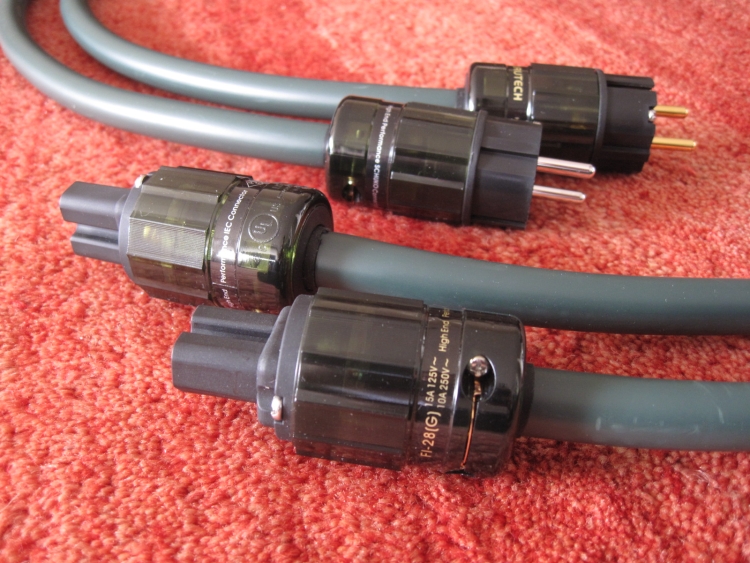
Comparing the new cable and connectors to the Alpha 3 and FI25/FI35 predecessors
Review samples kindly provided by Audio-Life
Retail prices:
FP-TCS31 cable: 150 euro per meter
FI28 gold plated IEC connector: 100 euro
FI-E38 gold plated Schuko connector: 100 euro
FI28 rhodium plated IEC connector: 130 euro
FI-E38 rhodium plated Schuko connector: 130 euro
Furutech intended the unshielded Alpha 3 powercable to be used with power amplifiers, leaving the digital source duties to their more affordable but screened cables. I found however that the Alpha 3 sounded most excellent with just about any audio component, and I have used it with great success in combination with a large number of DACs for several years. It is my experience that shielding in itself doesn not greatly influence the sound of a cable. Shielding can in fact alter the perceived low level detailing of a cable, but it’s the geometry and insulation materials than most influence its character.
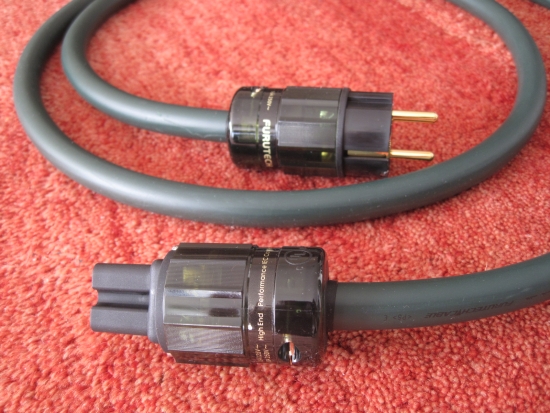
The Alpha 3 has now been replaced by the FP-TCS31, which is actually also a screened cable. Also discontinued are my favorite Furutech connectors, the FI25 and FI-E35.
Naturally I was now curious to see how the cables and connectors would compare and I figured that a nice comparative review was in order. This would however require several connectors and several meters of cable. Upon contacting Dutch company Audio-Life, Caspar was enthusiastic about my plan and more than happy to provide the required products for review.
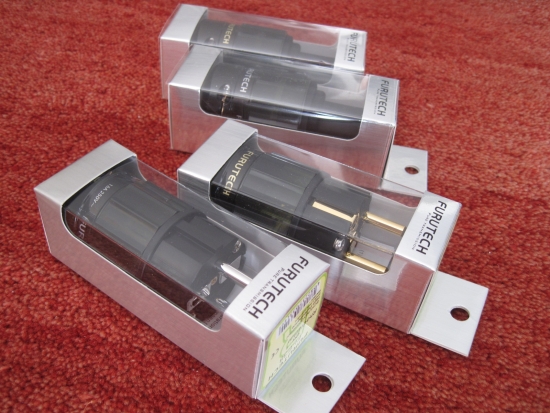
Comparing Connectors
Alpha 3 + FI25/FI35 gold plated connectors &
Alpha 3 + FI28/FI38 gold plated connectors
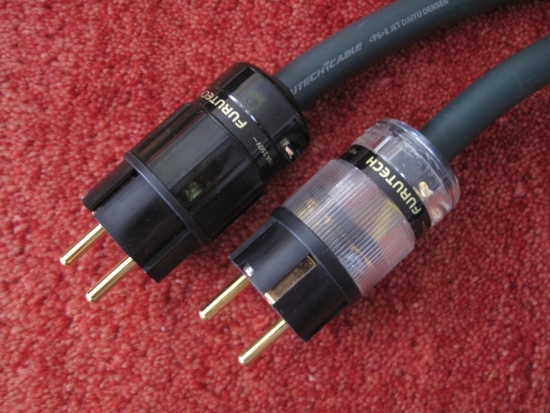
First candidates for comparison are the new FI28/FI-E38 connectors. In preparation, I have made two cables of identical length, one with the outgoing FI25/FI-E35 connectors and the other with the new FI28/FI-E38 connectors to enable direct comparisons. Both cables were run in the same amount of time, and connected to the same extension block output, with the same phase. First comparison is with the Wadia 25 DAC. This is a true oldie by now, but because the Alpha 3 matches so well with it, and I am very much accustomed to the combination, I’m starting off with this classic DAC. I will make the same comparisons using a Meridian 818 as DAC, which is a currently available product.
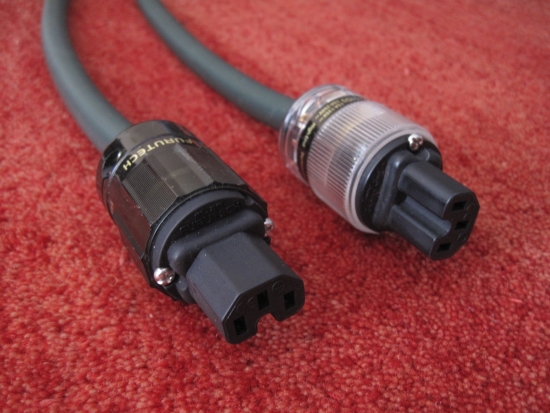
Construction
Both connectors housings are made from a hybrid of nylon and carbon and the conductors are pure copper with pure gold plating. There’s good news for the people who have had to deal with broken strain relief pieces as they are now made of non-magnetic steel, and impossible to break. The rest of the design is also subtly but meaningfully changed for the better, with new solid screw terminals for the schuko plug that allow the bare wires to be clamped in between two gold/rhodium plated metal parts in place of being screwed down directly with a screw as with the initial FI-E35 versions, so no more crushing of the litze in the process. Also there is newly designed earthing of all metal parts and a new classier looking green housing part. Overall, the new connectors now look and feel even more high end.
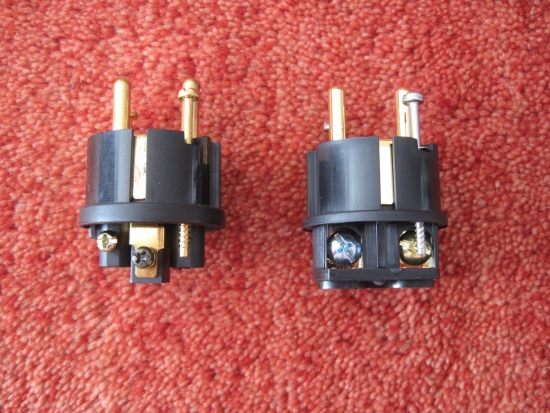
Above left: an early sample of the outgoing FI-E35 with normal screw terminals, top right: the new FI-E38 with solid clamps. Note that the most recent version of the FI-E35 also had similar clamps.
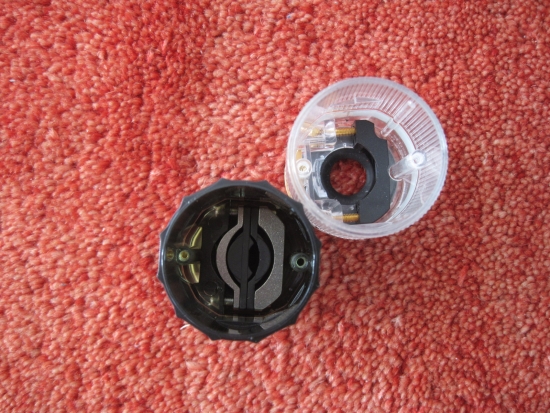
Above left: new FI-E38 housing with non-magnetic metal strain relief in place of the plastic ones of the outgoing models
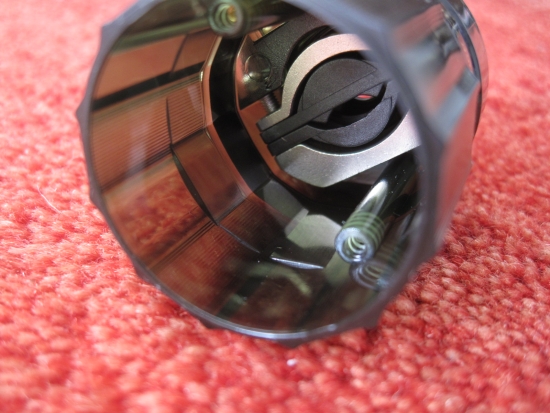
Wadia 25
The Alpha 3 with FI25/FI-E35 connectors matches very well with the Wadia 25, enhancing the DAC’s inherent qualities. Like most Wadias, the DAC is however quite dry in the treble and not very fluid overall. This can be fixed to some extent with warm and smooth sounding cables. I have tried such cables as Harmonic Technology Pro ACII+ with Wadias on various occasions, but this always seems to diminish the areas in which Wadias tend to excel.
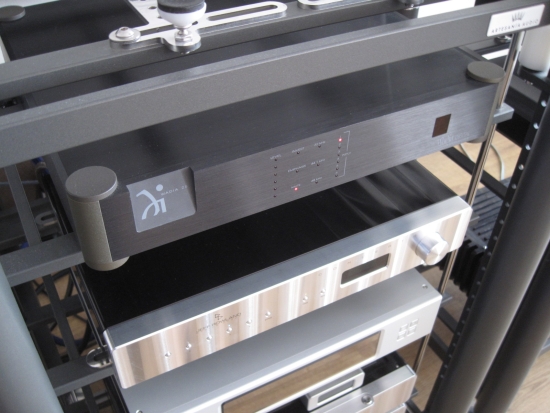
The beauty of the Furutech Alpha 3 is that it enhances focus and low level detail, provides great speed, dynamics and PRAT and adds a touch of body and texture in the upper midbass/lower midrange. Although the Alpha 3 is a very neutral and honest cable, it never seems to make the sound in any way hard or unpleasant, and in this implementation, it compliments that Wadia’s strengths, rather than compensating for its weaknesses.
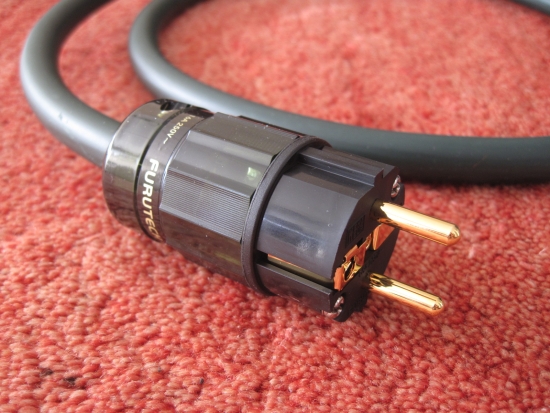
As a source I use an Aurender N10 music server. The Wadia is connected via S/PDIF using a Mad Scientist HDC+ cable.
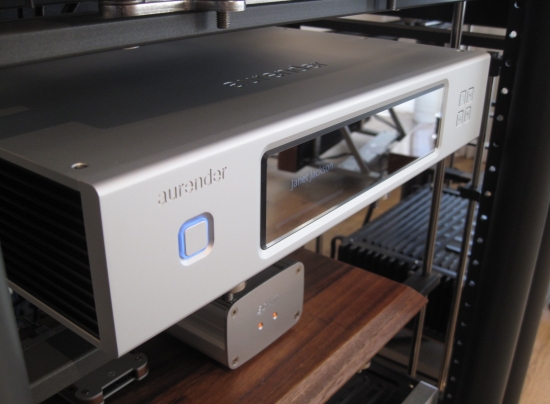
Switching to the new connectors I am truly amazed at the large difference in sound. There’s more body and timbre is richer, but without making the sound soft. What’s more, not only focus is improved; the soundstage is also wider. Remember we’re only talking about a change of power connectors! The cable is the same and has had the same amount of running in, is used with the same polarity and is connected to the same power extensionblock position. Listening closer I get the feeling that although the large dynamic swings are entirely intact, transients sharpness seems to be slightly less well defined resulting in a seemingly less immediate sound than with the old connectors. To confirm this, I’ll go back to the old connectors once more.
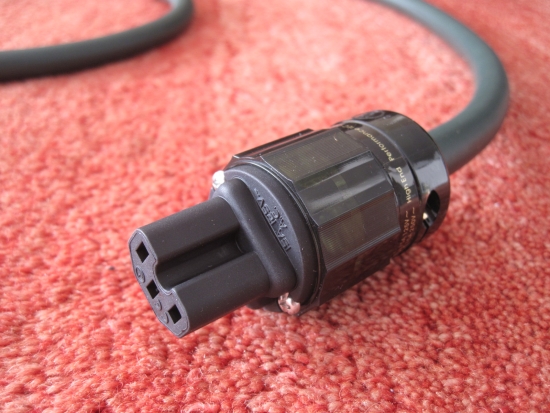
Well, maybe the old connectors seem to be somewhat more direct indeed, but that is only because they also sound quite dry in comparison. I’m not even so sure now that they are actually more dynamic, and what predominates is a feeling of having stepped down a notch in quality. Prior to this comparison I was already aware that the FI25/FI-E35 connectors sound most dry of all the Furutech connectors I tried, but at the time they also provided the best low level detailing of them all, and so I stuck with them. Listening to them now in comparison with their successors, there is no ignoring that the fulness of timbre is reduced considerably, as is the soundstage width, compared to their successors.
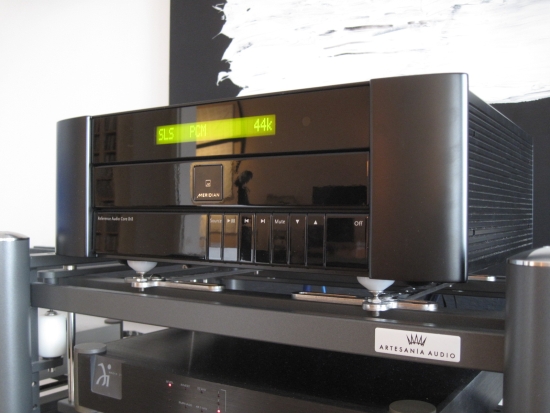
Meridian 818v3
The Meridian 818v3 is a modern an flexible device offering DAC, preamp and streaming endpoint facilities. To keep matters simple, its use for this test is strictly as a USB DAC. Source is again the Aurender N10, connected via an AudioQuest Diamond USB cable. Comparing between the Alpha 3 cables I hear similar changes between the FI25/FI-E35 and FI28/FI-E38 connectors: more body and richer tonality, along with a more expansive soundstage with the new connectors, without losing any detail or expression. The difference is quite staggering really, and although it is a little early to say for sure, I think I have found my new favorite connectors!
Comparing Cables
Alpha 3 + FI25/FI-E35 gold plated connectors &
FP-TCS31 + FI25/FI-E35 gold plated connectors
It’s now time to compare the new FP-TCS31 cable to its predecessor. I have connected a second set of the outgoing FI25/FI35 connectors to the new FP-TCS31 cable so that we can see how the cable itself compares with its predecessor.
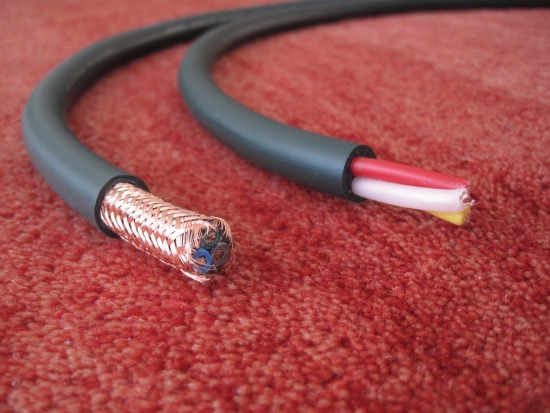
Above left: new FP-TCS31 cable with screening, right: outgoing Alpha 3 without screening.
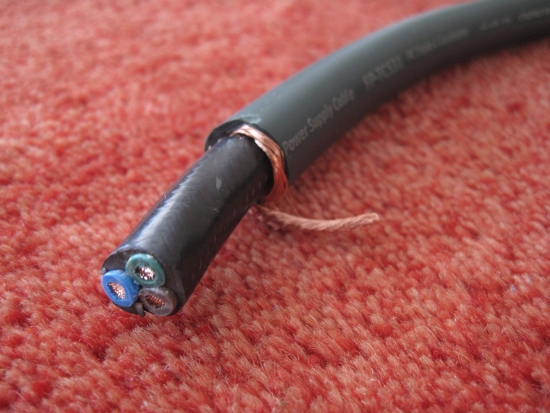
Above: FP-TCS31 cable with outer sleeve removed and screening mesh combined into a strand.
Construction
Unlike the Alpha 3 that is made from a combination of PVC and PE, the FP_TCS31 cable’s outer and inner insulation consists of “Special grade Flexible PVC”. PE is a bit like Teflon and so if the PE conductor insulation has been replaced with PVC, I would expect the cable to sound smoother than its predecessor. As always, when attaching the connectors I connected the shield to earth on the source side (extension block / wall outlet), but kept it floating at the destination side.
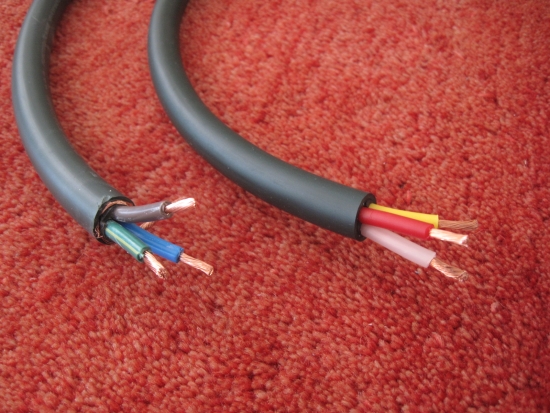
Above left: FP-TCS31, right: Alpha 3. As far as I can see, the individual litze conductors and the combined gauge seem the same size.
Wadia 25
Switching from the Alpha 3 with FI25/FI-E35 connectors to the new FP-TCS31 cable with the same connectors, again there is a marked difference in soundstaging. As with the new connectors, the FP-TCS31 manages to widen the soundstage considerably. Along with this change, the overall sound balance is also changed: bass is fuller and fatter, midrange is warmer and more liquid, and treble is more fluid. While the outgoing Alpha 3 cable could be accused of sounding somewhat dry, this is definitely not the case with its successor. Overall I’d say that the FP-TCS31 sounds closer to the global Furutech sound than did the Alpha 3, which was something of a deviation from their smooth house sound.
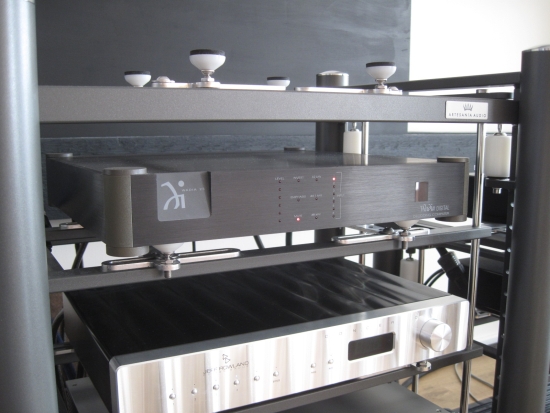
This begs the question: is the new cable as lively and articulate as its predecessor? Swapping back to the old cable again confirms that this indeed not the case, the Alpha 3 being more immediate and articulate and more forward in the midrange. But in comparison to its successor it is also tonally a little dull and matter of fact. The FP-TCS31 by contrast is a warm bath with smooth, full and rich midrange, and no diminishing of fine detail, but indeed a certain reduction of attack and clarity in the midrange.
Meridian 818
The Meridian 818 is every bit as dynamically differentiated as the Wadia 25, but differs in treble presentation, which is quite a bit more fluid, meaning that dry sounding cables such as the Alpha 3 match very nicely. This could lead one to fear that the much smoother sounding FP-TCS31 cable could sound overly smooth when matched with the Meridian, but this is not the case. It’s likely partially thanks to the 818’s excellent rhythmic and dynamic expressiveness, that the energy and drive is effectively retained.
The FP-TCS31 is certainly more creamy sounding than its predecessor the Alpha 3, and shifts the working point from tight and forward to fluid and relaxed, but matches with the Meridian just as well as did its predecessor.
At this stage I thought it would be a good time to swap back to the Alpha 3 cable with the new FI28/FI-E38 connectors. Interestingly, this provides a somewhat similar overall sound as with the FP-TCS31 cable with FI25/FI-35 connectors, but with more drive and presence. At this stage, this would seem to mean that the ideal balance is obtained by combining old and new elements, and in some situations this might indeed be the case but later comparisons with a third source component will prove that this is also relative.
Going back to the Alpha 3 + FI25/FI-E35 connectors one final time, I do hear that midrange is a little bit more spritely and midbass a little more articulate, but the sound is also gray and uninspiring in comparison and I can’t help but feeling that this is quite a large step back overall.
It seems that these new connectors really are some kind of magic-inducers!
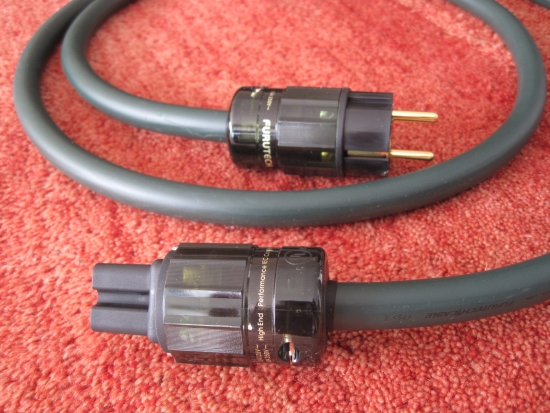
Comparing Gold and Rhodium Connectors
FP-TCS31 + FI28/FI-E38 gold plated connectors &
FP-TCS31 + FI28/FI-E38 rhodium plated connectors
Going from the Alpha 3 cable with FI28/FI-E38 connectors to the all new combination of FP-TCS31 + FI28/FI-E38 gold plated connectors it is interesting to find that even though the overall sound is more relaxed, it is plenty powerful and there is incredible detailing, but presented in a natural manner, without any etch. It seems that the new connectors lift the new cable’s spirit to arrive at a combination of each of the components’ best features, resulting in a sound that is smooth and forgiving, but neutral and highly detailed.
And now for the piece de resistance (forgive my lazyness of not using accents): the Rhodium plated connectors. Previous experience with other Furutech connectors has informed me on what differences to expect, but given the incredible results with the FI28 and FI-E38 gold plated variants I am expecting even more from the rhodium ones.
And indeed, the Rhodium connectors really deliver! Compared to the gold plated variants, the sound remains smooth, but with more explicit detail, more energetic transients and even slightly increased perceived speed. After a while however I do notice that there is now less of the “golden” shimmer that the gold plated connectors offer, there’s less romance in the air, in spite of the overall still warm and relaxed feeling. But, this is in combination with the Meridian 818 which is itself not a smooth sounding component. Remember my always going on about the importance of making the right combinations? That’s why I will throw one final audio component into the mix.
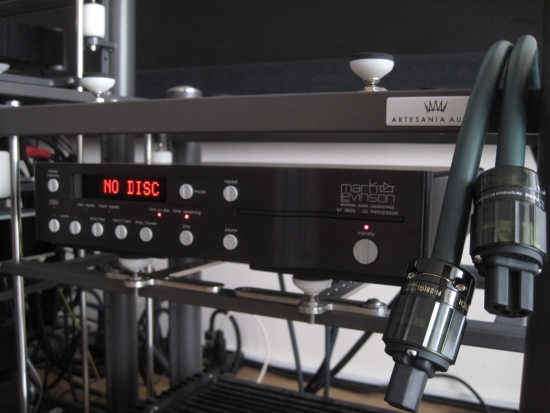
Mark Levinson 390S
The 390S CD player is something of a classic by now, but my unit has recently been checked completely. It has been treated to a new transport and all its critical capacitors have been replaced and after a period of running in, it now sounds as good as new. Even if you won’t find many reviews carried out using this player elsewhere anymore, being a constant factor throughout many of my reviews however hopefully it is still a good point of reference.
FP-TCS31 + FI28/FI-E38 gold
My default cable used with the Levinson for the longest time has been a Harmonic Technology Pro ACII+. This cable is admittedly a little too relaxed, but it enhances the player’s inherent smoothness nicely, making for a more seductive and relaxed sound than is usually expected from CD.
Going from the Pro ACII+ to the Furutech FP-TCS31 + FI28/FI-E38 gold plated connectors I am surprised to hear that the Furutech is much more upbeat and articulate, and dynamic expression is also lots improved, with a feeling of better PRAT as a result. Even though I classified the FP-TCS31 above as a smooth sounding cable, it is actually quite a lot more neutral than the Harmonic Technology Pro ACII+, which is nicely offsetting my initial impression. The Pro ACII+ does have seemingly more fluid (less dry) treble, but does this by adding considerable smearing across the frequency band. This can indeed ameliorate “digital” sounding recordings but the price to pay for this forgiveness is less of the toe-tapping quality and a timbre that is less than convincing. The Furutech’s timbre by contrast is highly natural and absolutely acoustically convincing.
FP-TCS31 + FI28/FI-E38 rhodium
Going from the new Furutech FP-TCS31 cable + FI28/FI-E38 gold plated connectors to the same cable with the FI28/FI-E38 rhodium plated connectors the big surprise is that treble is now more fluid and refined, but without adding any smearing. In fact, the whole frequency range is spot on neutral top to bottom and transparency seems even better than with the gold plated connectors.
Just as with the Meridian, I can hear that the Rhodium connectors have a cleaner sound which makes the music sound more upbeat, neutral and transparent. The Levinson however is quite a smooth sounding player itself, and the combination still retains the warmth and richness for which I like the player so much, and there is still a seductively emotional quality to the music. In fact, this may be the best cable I heard with the 390S yet.
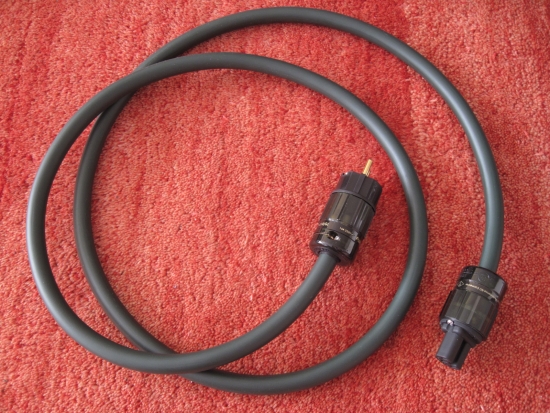
Conclusion
New versions of existing products don’t necessarily need to be better than their predecessors, certainly not for everyone and every situation. Furutech’s new FI28/FI-E38 connectors however can definitely be labelled as a large overall improvement over the FI25/FI35E connectors that they replace. The new FP-TCS31 cable is more of a deviation from the Alpha 3 cable that it succeeded, but sounds more in line with the overall Furutech house sound as present in the majority of the Furutech lineup. While less articulate and certainly more relaxed and smoother than its predecessor, the FP-TCS31 cable manages to extract more detail from recordings and sounds more powerful and more colourful, with a lager soundstage as a bonus.

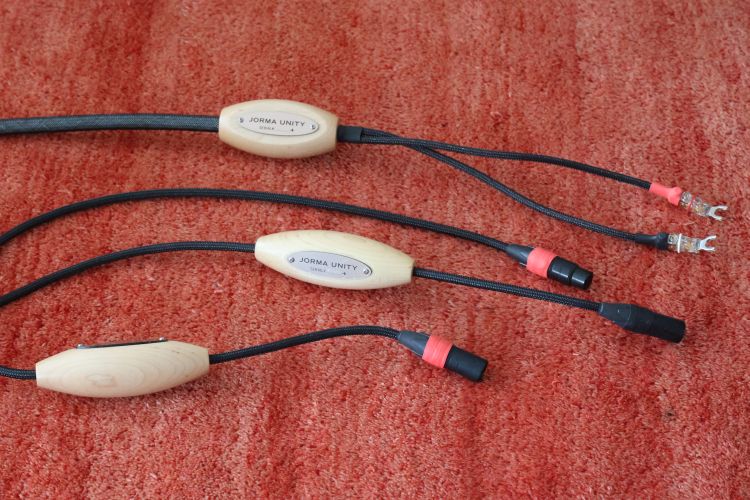
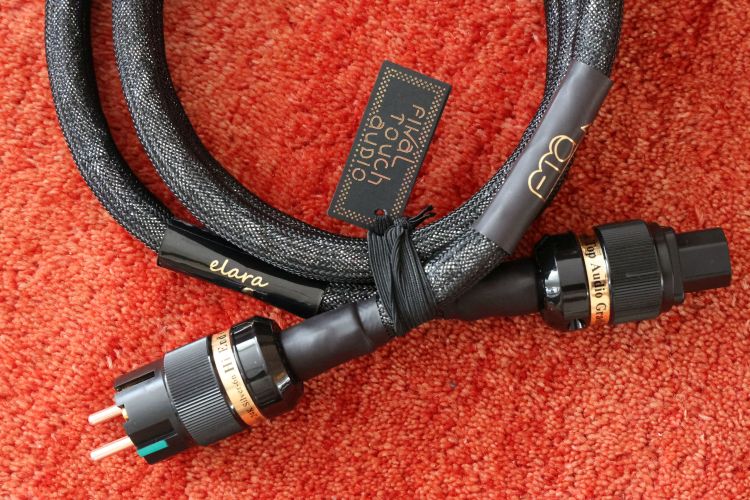
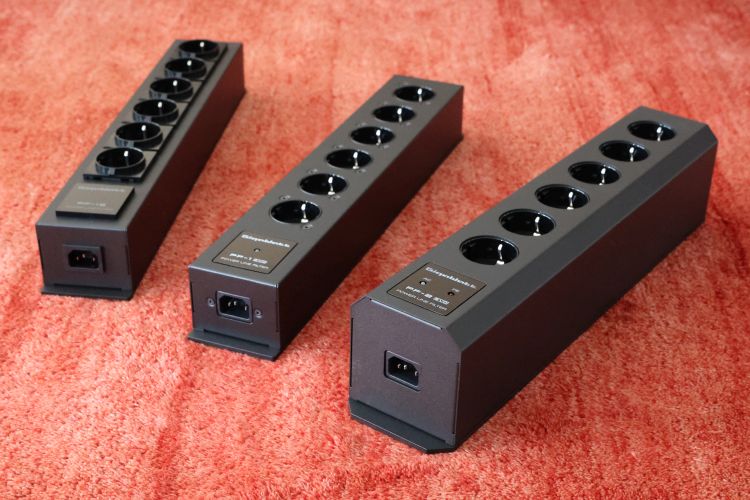
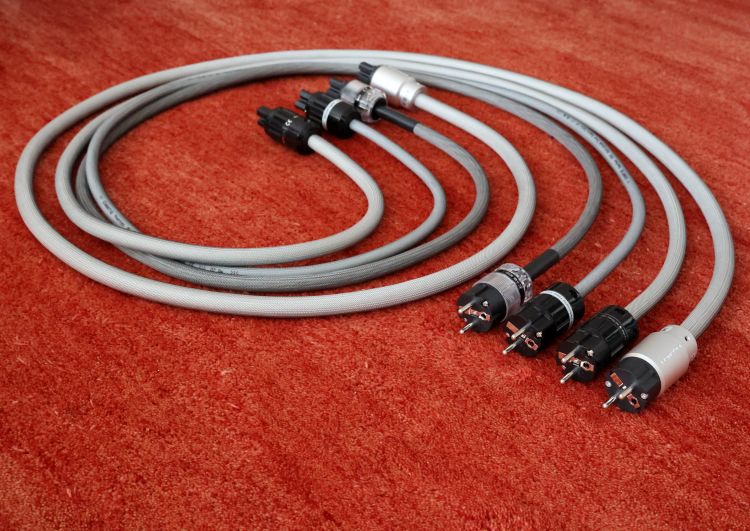
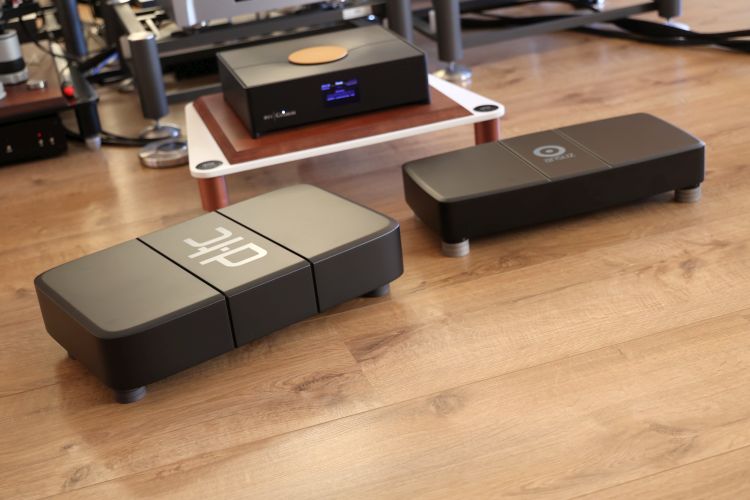
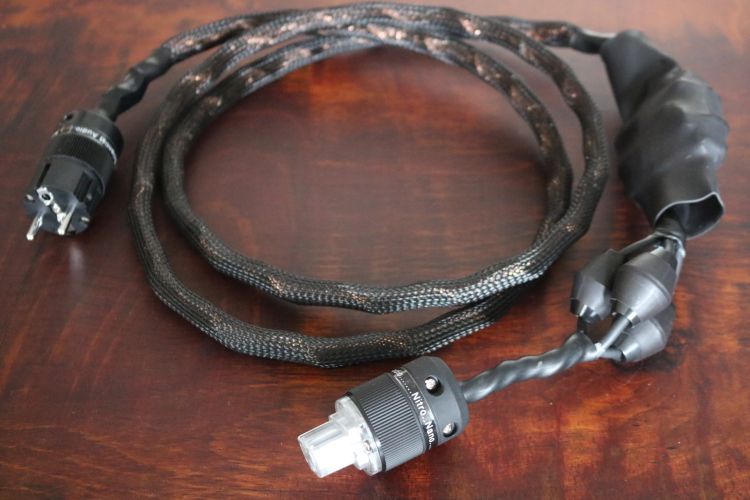
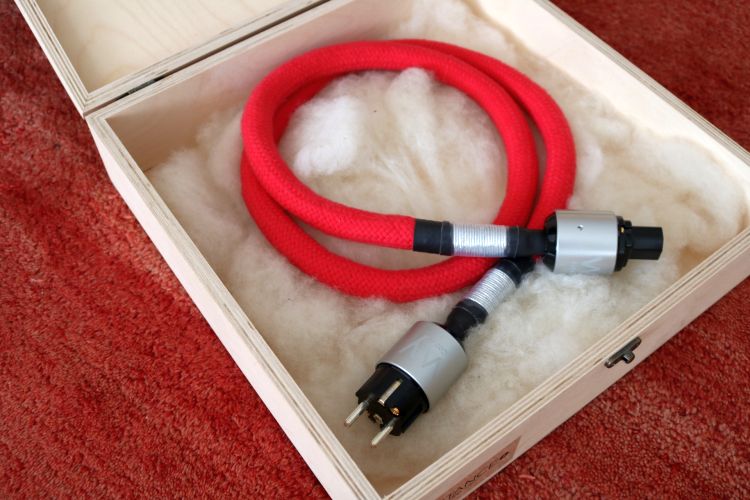
Hifi-Advice is making life for Audiophiles like us so easy, with great and opjective reviews. I always get a little nervous when I come across a review that I find interesting, so also this time, and I hoped the new Furu’s would bring it on. I have them myself and already noticed the good sound quality of these new Furutech power plugs, but never took the time to make a direct comparison with the older series, and also never thought the differences were this big. It confirmed the feelings and you’re on the right direction of the audio heaven path way. So let’s upgrade the system some more, and mail Audio-Life for some more Furutech connectors, Life is good!
Thanks and regards, Eddy
Hello Christiaan,
Wonderful & honest reviews you have there, you really make life easy for us Audiophiles.
However I need some advise from you. I’ve been planning to build a pair of the FP TCS31 terminated with IeGO connectors for a set of my monoblocks, needless to say for drawing high current. I live in a 220v environment.
Have you ever used the Neotech 3200? Would it be fair to say, Neotech 3200 is an old version made ~2004? Is it true that They have well articulated bass but somehow being shy on high frequency sides.
Is it true that, New version of these PC are NEP-3001,2,3 MkIII which are UP-OCC Copper / Silver Hybrid. NEP 300X mkIII series are more balanced all over frequencies and are much better than old series??
I have a few other cables shortlisted, but I would like you to recommend a cable from your lineup which would serve my purpose without breaking bank 🙂
Furutech FP-S35N
Furutech FP TCS31
Furutech FP 3TS762
NeoTech NEP 3200
Nanotec #308
I intend to go with the Furutech GTX-D (G/R??) receptacles & the iego 8085 (G or R??)
Thank you & best regards,
Ben
Hi Ben, Alas I have no experience with Neotech and from the Furutech range I can only comment on the models that I tested in this review. From their specs I’m afraid that it is impossible to predict how they will sound. I do also have a 3TS20 and if the 3TS in its name is anything to go by compared to the 3TS762 you mention, then this could be the smoothest sounding cable of the bunch. But this is pure speculation on my part. One thing all Furutech cables have in common is their fluid, rich sound. Adding one or two of these cables can really work wonders. But depending on circumstances their warm character can also translate to the impression of not having enough attack in the bass. In generic with a strong company signature such as Furutech’s in mind I always caution against using too many of the same product. If you already have some Furutech cables in your setup then it might be good to balance things out by adding typically “tighter” sounding cables. A cheap way to determine which direction you should go is by using simple but very neutral Belden power cable. Does it sound too clean, too edgy or too thin? Then changing the Belden for a Furutech will likely yield more musical results, while also enhancing microdetailing and treble fluidity. Regarding the IeGO’s: the R versions sound more refined and airy, but lose some fulness of tone compared to the G ones. When using a Furutech cable, R can work very good though. Also very good are Oyaide connectors, I have very good experiences with the double gold plated ones, and less so with the ones that utilise more exclusive metals. Regarding high current: all properly designed power cables can carry the required current for any power amp drawing from a 16A circuit. While some cables may well sound more “powerful” than others this is not because they have more current capacity but because of other aspects of their design. It is also possible for a thinner cable to sound more punchy than a big fat one. My point is that these matters are relative, and only your ears can be the judge.
Hi Christiaan
A year ago I asked your for some advice on cables to use in my setup (going for a smooth and full sound), on the page with the Taiko Nagado review, which seems to have disappeared.
As I was using Lapp then, you suggested going for the Furutech FP-TS31 with FI-28 /FI-38 gold connectors or even further in that direction the Taiko Audio Nagado. I bought the latter cable and use it with my Meitner MA-1 with success. I also asked you which cable to use with the JRDG Continuum S2 and you suggested the Cardas Clear instead of the Taiko Nagado but I can’t remember why anymore and as the comment on your website is gone, I can’t consult it anymore. Could you remind me again what the difference is between the Taiko Nagado and Cardas Clear? Thank you in advance.
The Taiko review has been put back in draft state pending the distributor getting his affairs in order. However time contstraints have led to the project being set aside for the time being. The comments are still available and I have read back our trail. Basically I recommended the Cardas because two Taiko Nagados might be overkill, making the sound too relaxed (and indeed you later mentioned a loss of foot-tapping rhythm when used with the Rowland, and decided that it worked best with the Meitner). In general, the Clear also just works very well with a wide range of JRDG gear.
Thank you for your reply. Is the Cardas Clear leaner sounding in comparison? I’m using a second Taiko Nagado on the JRDG at the moment and a Shunyata Python Helix VX on the Aurender and it seems to take away the digital edge. But I was thinking the Cardas Clear might indeed be a better match for the JRDG Continuum S2, but I don’t want to go to a leaner sound.
The Clear Beyond is not lean in itself. It is quicker and more articulate but it has a lot of copper and also has excellent tonality and bass. However, it is more neutral than the Nagado. The latter has a smoother, richer presentation with a more laid-back midrange, which might translate to a subjectively fuller bass for you.
Hi Christian and congratulations for your excellent work.
I have read that it is important to match the platings on connections (rhodium outlet with rhodium schuko OR gold outletwith gold schuko). would you believe that this is valid?
Also would a power cord with rhodium on one end and gold on the other share some qualities of both worlds?
In general, the most even-handed results are obtained using similar platings, so gold with gold etc. When using gold, you go for a slightly warm and smooth sound and when combined with Rhodium on another connector, you add some refinement and articulation but you also cool down the sound a bit again, which may or may not be desirable. Sometimes combining two opposites does indeed combine the strengths of both connectors but more often than not, the result is sort of like the worst of both worlds.
Then again, two identical materials enhance the effect but may also push the effect too far, depending on your situation. Oyaide 079 Schuko + 079 IEC, for example, sounds extremely smoooooth, arguably too smooth for many people. I find that some “mismatches” can also turn out to work great. For example, my power extension blocks use brass strips and I mostly use Oyaide P-29 (pure brass with no plating) schukos with C-004 (platinum+palladium) IECs on Belden cables that combine in a very neutral cable which works well with all components that I tried it with so far. I tried all the Oyaides that I could find and as part of this test, I found that the same P-29 did not match well with silver+rhodium or gold+palladium. The latter two each had their own qualities but resulted in an uneven, unbalanced, sort of peaky sound.
Also read the Oyaide review: https://www.hifi-advice.com/blog/review/accessories-reviews/oyaide-c-037-c-046-c-079-and-c-004-iec-connectors/
So, it remains a bit of an experimentation and you can end up with a good combination. If you want to play it safe, however, it is better to choose a direction and go with it all the way for a given cable. If you want to tweak the system’s overall sound after that, then it is best to do this on a component by component base, so using one type of cable for one component and another type for another component, just as they match best.
thanks for your detailed and prompt reply. since my system sounds better with gold, i thought that changing the final iec to the component and the components inlet and fuse woul d give me some balance. One final question, although i guess you havent tried it side by side and it will be a little risky to answer. what would the differences be between oyaide 046(phosphor bronze contacts and 24K gold + palladium plating) vs furutech 28/38 (copper contacts and 24K gold)?
Oyaide 046 is a good connector, but you can do better with other Oyaides. If you read the Oyaide review (as linked to before) you’ll see why. I think I would prefer Furutech 28/38 for I suspect that they will be more refined and detailed than the 046, while still sounding very smooth and relaxed.
Hey there
Well you have very good details in your review.
I am in a big delema to choose for furutech
My first option is tcs31 with fI-28 (R) and fI-e38(R) and the 2nd is the evolution power II.
Well i know that they have 300euros distance…but in sound is very different?! the evolution power II doesn’t say purity 99,996 and have the cheap connectors.
Maybe you don’t have listened to the evolution power II but i think your experience can tell me to choose the right one.
thanks in advance
Hi Nick, I’m afraid that I can only guess as I have not heard the Evolution power cable. However, my guess might not be far off:-) I know that confected cables are more expensive than making them yourself meaning that the premium is not necessarily a mark of better quality and I also know that the FI-11 IEC is a considerably more mundane connector than the FI-28/FI-E38. If I had to make an educated guess then I’d say that making the cable yourself will yield more refined results. The only thing I don’t know is how the power cables themselves compare. They use similar techniques but if even the insulation is different they can already sound very different.
Bonsoir , quels connecteurs schuko preferez vous entres les furutech fi -e38 or ou rhodium? j aime la douceur,aeration,tenue, Cordialement Franck
Hi Franck, translated you posted the following: Good evening, which schuko connectors do you prefer between furutech fi-e38 gold or rhodium? I like the sweetness, airing, “holding”. Now, I’m not sure what you mean by the last word but I can tell you what I think of the gold and rhodium FI38’s. The Rhodium is even more precise and a little airier but also a little cooler in tonality, a little bit more technical to my ears. The Gold is almost as detailed but smoother and warmer and this is the one that I prefer.
Hi Christiaan,
In my system I preferred the 28 in gold which seems more homogeneous to me, the 28 in rhodium the treble and upper mids are defined without being aggressive, but this is done a little to the detriment of the bass, if what you are looking for is to provide a little more of clarity in your listening then rhodium is the right choice.
My system already has sufficient clarity and transparency. The OCC cables with the 28 in gold work quite well.
In my Phono preamplifier there is the doubt, I continue testing rhodium vs gold, checking the 28 in rhodium that is appropriate for digital vinyls, however in analog vinyls the 28 in gold is the most defined.
Will this be a conclusion? I dont know yet. What do you think about using the 28 in a Sutherland DUO LPS Phono Preamplifier?
Thanks,
Hi John, perfect reasoning, fully agreed. Regarrding the ideal connector for your phono stage, that will be an entirely personal matter. Maybe you could also try other brands, like Oyaide. In the end, our ears are the main guide. So, I always just recommend to try things out and see what works for you.
Bonjour, pour vous la schuko furutech fI 38 or est la meilleure des schuko or? j ai la iego or schuko je la trouve un peu montante et maigre , j espere que la furutech n est pas pareil . Merci Franck
Hi Franck, I am not great with French, so please can you use Google Translate or something similar to create an English text before posting it? Thanks, CP
Bonjour , est ce que pour vous la schuko furutech FI E38 or est la meilleure schuko ? merci
Yes, I forgot to clarify, that after sufficient time when I rotate the direction, the opposite than indicated direction sounds better again. And this is always the case with Furutech cables. I’ve let cables to run enough time in both direction, like several months. Oyaide direction for example matches my “correct” sounding direction.
Ok, so even after a lot of running in using the opposite direction than indicated, you keep preferring it over the correct direction. That’s an interesting observation worth investigating. I have sufficient cables now but if I make another Furutech I’ll keep this in mind.
Hahaha the adorable french. They can read a review in English but they will never write or speak ?
Bonjour, connaissez vous les connecteur charlin? est ce que la fi 38 gold furutech est elle dynamique pour tenir le grave du tcs 31 furutech ? merci
I’m sorry but I cannot respond to questions in French. Please use Google translate to arrive at an English text to post.
Bonjour , la shucko furutech gold fI 38 serait elle la meilleure schucko pour vous? merci
Hi Franck, No, the FI38 is not “the best” connector that I know. That would be the Oyaide 004. DO PLEASE NOTE, as indicated before, if you want me to respond then please translate your questions, for example using Google Translate.
Hello Christian !
Great reviews, thank you very much for your time!
I am running Accuphase devices using Alpha3 for CD and FP-3TS20 for the Amp. Both of the cables are built with Neotech Gold connectors. Sound is not bad at all, but i feel-it a bit too much on the treble side. I am going to replace Neotech with Furutech 28/38 Gold. I hope it will reduce the hights a little bit. Do you have any other suggestions for me to try ? Thank you in advance!
Furu 28/38 sure are refined and smooth sounding connectors but I don’t know the Neotechs so I’m not sure how the balance would shift precisely. Have you ever swapped the Alpha3 and FP-3TS20? Sometimes a cable works better with one component than the other. Also, you might look at finding another Alpha3 to replace the FP-3TS20. Personally, I much like the acoustically convincing nature of the Alpha3 (although some people find it sounding dry) but find the FP-3TS20 to be a little bit too smooth and too filtered and I think you may find that it attenuates the midrange energy somewhat which might also attribute to your feeling of having too much treble.
Yes, I tried to swap the 2 cables. Alpha3 was working better with DP550 (used as a DAC). Maybe i should order an FP 3CS31 with Rodium connectors. But I’ll take-it one at a time, first I will change Neotech with Furutech and I’ll see what happend…
Thank you !
Hi Alex, while the FP-TCS31 is certainly a round-sounding cable with absolutely no treble highlighting, it should be noted that it is a lot warmer and more relaxed than the Alpha 3, just FYI. Rhodium 28/38 connectors are highly refined but also seemingly more open and linear than the gold variants meaning that if you want to tame your treble, perhaps the gold ones might be a better choice, even if they appear to be less explicit.
Hi Christiaan,
Would you recommend using FP-TCS31 & gold 28/38 connectors with LM-150ia. Do you think is it possible to have more fluid, relaxed, and detailed/transparent sound from k150s? Or would you consider testing it first with Weiss Minerva DAC (My DAC) and then LM-150ia? I would just like to have your expectations, thanks in advance.
Indeed, the TCS31 might work better with the Minerva than the LM150IA amp. While this amp sounded tight and controlled in my listening tests with the Wilsons, it sounds very smooth, warm, and liquid when combined with the Apogee Duetta Signatures in a friend’s system. In this case, a standard Belden 19364 is used and in his system, the Furu would be too much. The combination of fluid, relaxed, and detailed/transparent is certainly possible but the best cable to use to achieve this depends on your partnering speakers and your personal taste. Assuming that you find in your situation that the LM150IA could do with a creamier, smoother presentation, and your bass is currently plenty fast and articulate, then I’d say go for it. If you think that the sound should not become any more relaxed and you want the maximum in bass articulation then maybe it’s better to select a different cable.
Dear Christiaan,
My speakers are JMLab Mezzo Utopia speakers @ 4ohm / 91.5 db (It could go down to 89.5 db according to some of the tests). Maybe they could be considered on paar with Wilsons. Would you try TCS-31 and 28/38 g if you use Lm150ia with Wilson Watt/Puppy 8’s?
Ah, those don’t seem to be very difficult to drive, but like the Wilsons, they may have a shift in phase at a certain frequency. Considering that the JMLabs of that era are somewhat spicy in the treble, same as the WP8, but nicely upbeat and dynamic, Furu TCS31+28/38 may well work very well with the LM150IA. It is a cable that will make the best of the amp’s rich midrange, with high resolution and a relaxed feel.
Hi Christiaan
Thanks for a good review. Always a pleasure reading ??
I have a question for you… I am looking for a new power cable going from the wall schuko wall socket to the PS Audio P10 powerplant. It is about 8 meter
My system is Bricasti M12 +M15 and Ktema speakers from Franco Serblin.
What kind of powercable should I be looking for ?
The connectors will be Furutech Fl 50 and Fl-E50
Those are used in the setup too
All the Best
Michael Gravlund
Hi Michael, for the main cable leading to the system I would advise to use either a Belden or solid core installation wire, depending on the sound that you want to achieve. The Belden has more open treble, some say harsher but I don’t hear it that way. The installation wire has bigger and more solid bass but is also slightly dark compared to the Belden. Personally, I favor installation wire for its overall tighter and least filtered sound. In general, I don’t feel it is necessary to use high-end wires as main cables. These are better applied between the extension block and the components.
Hello,
thank you for the great reviews!
I will suggest something, that I found accidently to bring better results in my system – why don’t you connect Furutech power cable in opposite direction of signal flow.
It’s strange, but only on my Furutech cables, the direction stated on cable is sounding “wrong” to me. For the record, I’m disassembling the cable and I’m using the separated wires for my applications. I’m aware, that in Furutech’s power cables, Live wire is in opposite direction than Neutral and Ground.
All other cables with direction flow I have are with “correct” direction, like Oyaide cables, for example. They also put Live wire in opposite direction than Neutral and Ground in their cables.
I’ll be curious about your findings about Furutech’s direction of signal flow 🙂
Hi Yanakiev, it’s a good suggestion. However, I noticed that cables can be run in in either direction. Even if you start with the non-indicated direction, it can become the “ideal” direction with enough running in. This may not go for all cables but I think it will be the case with the majority. So, in order to be sure that you remain happy with your reversed cables, I would suggest keeping checking the result now and then after some use. You may find that the directions grow toward each other.
I’ve tried running wire in indicated direction for more than year and after few seconds in “correct” direction (opposite than indicated), sound became way better.
That makes sense. But what I propose is that you try reversing it again after a certain period of time. Perhaps the sound will revert to what the other direction sounded like when you did not like it.
Hi, I would like your suggestion for the furutech power cables. Do we need the TCS31 for the phono, cd or streamer or the less fat and more flexible TCS21 is enough?Price is not an issue, only the musical result result matters.
Thank you for your time
Themis
Hi Themis, I’ve not used the TCS21 but, in general, I find that cable properties, while potentially variable in proportion, are pretty much the same no matter what component you use them with. One thing to keep in mind is that the TCS31 has 2,5mm conductors while the TCS21 has 1.9mm conductors. The other specs don’t indicate any other changes such as the formulation or thickness of the insulation material but from comparisons with thick and thin Belden cables (2.1mm versus 4mm) I know that there are very audible differences between the two. I’m afraid you won’t know until you have tried it.
Hey!
Thanks a lot for your review!
I have a question for you about Furutech FP-TCS31 and Furutech FP-Alpha-3 cables.
The other day a friend sent me to wiretap FP-Alpha-3 with Furutech 28/38 connectors with gold. I liked the cable. I liked its wide stage, smooth and comfortable sound. But there was a little lack of sharpness at the high frequencies. I think this can be fixed with 28/38 rhodium connectors.
But then I came across your review and became interested in FP-TCS31. I was especially intrigued by your conclusion about this cable, where you said that it has an even wider scene, better details. But it also has a more relaxed sound.
And here are my questions:
How does the FP-TCS31 sound at high frequencies? Does it have more detailed sound on highs? Or does it, on the contrary, round off the top even more?
How is FP-TCS31 lowercase compared to Alpha-3? Is it more or less? Is it deeper or less dense?
The third question relates to the smooth sounding of the FP-TCS31. If now, listening to the Alpha-3 sent to me for testing, it seems to me already quite smooth, given that my Holo Spring 2 KTE DAC already has a soft sound … Will there not be an overabundance of “softness” in my system with the FP-TCS31, even with rhodium connectors?
Thanks in advance for your reply.
Best regards, Evgeny.
No Furutech product will add sharpness in the high frequencies, nor will Rhodium-played products. Actually, all the ones I heard have exceptionally smooth and fluid treble but with a leaner / “whiter” sound and more air than the copper/gold variants. FP-TCS31 is even smoother than Alpha 3 and although it is more refined and perhaps indeed deeper, it is also softer and more relaxed than Alpha 3. So yes, if Alpha 3 is already on the smooth side for you then I’d not recommend FP-TCS31. What you could try is leave the IEC connector but change the Furu Schuko for a Bals Schuko or something else that is fairly regular, to even out the smoothness a little. Finally, combining Furutech with leaner and cooler cables can also work well.
Hi Christiaan,
Although it’s a few year old, this is still a very good and useful review. Especially as the products are still available. The web is flooded with equipment reviews but this type of thorough reviews are rare and very interesting for many audiophiles imo.
I would be great to see some updates with the latest high-end NCF connectors from Furutech too. Keep up the good work! 🙂
Hi Christian,
II borrowed a Furutech FP-TCS31 cable with 28/38 gold connectors for my Elekit TU8600 amp (300B). Great! As you mention in your review: smooth, detailed, deep and wide soundstage. Now I’m considering connecting all my equipment (DAC, streamer, switch) with these cables/connectors. Do you think this wil give syntergy? Or should I put some other cable/connector in the mix? ‘m especially interested in the LeGo connectors because they are considerably cheaper. Which LeGo connectors do you recommend with the FP-TCS31? Or should I use another cable for LeGO? Thanks!!! Best regards, Anko de Hoop
Using more Furutech products will further enhance the aspects you mention. However, depending on what you are after, you can take it too far and end up with a sound that is so smooth and polite that it loses excitement. For me, the best balance is always achieved by mixing and matching, but opinions on this diverge. I would recommend taking it step by step and trusting your ears. I would also suggest trying Oyaide connectors. My personal favorite is teh C-004. Oh, you don’t necessarily have to use the same connectors for Schuko and IEC (both ends of the cable). A simple Bals schuko with a Furutech or Oyaide IEC can work very well.
Hi Christiaan,
Thanks for your reply. I will follow your advice and try step by step 👍
I know this is a very old thread, but just letting you know that the difference between the Alpha 3 and the TCS31 is so profound that after having used the Alpha 3 for around 10 years, I started becoming weary of the fatiguing edgy upper mids and moving to the TCS31 has made my system completely smooth, delicate, unfatiguing and with more body. As per usual Christiaan you have nailed it with the description of the sound differences between the two, I have found them to be identical to my findings. Thankyou. Andrew
Thanks for the nice feedback, Andrew! Much appreciated:-)
Hi Christiaan,
I truly enjoy your reviews and the depth of it.
I recently tried a Furutech S55N with 50-NCF connectors on both sides. I love most of this cable. Except the punch/attack of the upper bass. It is rather lean and could do with more impact. I have so far only tried Furutech S032N and the TCS31. Both versions I tried with a variety of Furutech connectors (gold/rhodium). I like the blue S032N and S55N cable over the green cable (tcs31). I love the clarity, staging, silence and depth of the S55N with the NCF connectors. But I like the bass fullness of the S032N with gold 38 connectors.
Do you have any advice for me what cable or connectors I should try to achieve what I want?
I have been re-reading my comment and actually I described it wrong. There is punch and attack but it’s a bit lean. I could use a bit more meat on the bone so to say. Some bass frequencies could do with a bit more fullness.
In general, the more precise a connector is, the “leaner” the bass may appear. It’s a matter of finding a working balance in any given setup using not just a single type of connector and cable. Sometimes, it works well when using different connectors on the same cable. For instance, a neutral and clean schuko with a smoother, more fluid IEC. I’m afraid the best advice I can give is to read my connector posts, choose some variants, and experiment away!